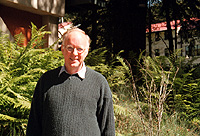![[Currents header graphic]](/homeart/currents_header.gif)
![[Currents header graphic]](/homeart/currents_header.gif)
March 22, 1999
When architects designed the Colleges Nine and Ten academic buildings nearly ten years ago, they were charged with creating a sense of harmony between the two structures.

|
|
John Isbister poses in a sunny spot in front of Social Sciences 2. Social Sciences 1 is in the far background.
Photo: Francine Tyler |
True to the intentions of college planners, Social Sciences 1 and 2 closely complement each other--down to the color of paint. Each a different shade of beige, the buildings sit among trees and meadow north of McLaughlin Drive across from the Cowell Student Health Center. The red-orange roof of Social Sciences 1 echoes the dark orange highlights on Social Sciences 2.
Perhaps the architects succeeded too well in their attempt at harmony, said John Isbister, chair of a planning-advisory committee for Colleges Nine and Ten. "The buildings are so friendly, it's hard to figure out why they should be two separate colleges," explained Isbister, who is also provost of Merrill College and a professor of economics.
How to address the similarity between the two buildings as they become the centerpieces of full-fledged colleges over the next few years--or whether Social Sciences 1 and 2 should become part of one larger college--is one of the questions Isbister's committee is grappling with as it sets a course for Colleges Nine and Ten.
Other questions the committee is discussing include what the new colleges' theme or themes will be; when the colleges will open officially; what the process and timeline should be for building enrollments and organizational supports; and what additional services and buildings should become part of the new colleges.
The planning-advisory committee plans to present its recommendations to the Student Affairs Division in late May for consideration by Vice Chancellor Francisco Hernandez of Student Affairs and, ultimately, Chancellor Greenwood.
Time is growing short for the campus to make decisions about Colleges Nine and Ten, Isbister acknowledged. Residential apartments are scheduled for completion in January 2000 with 280 bed spaces, and freshman residence halls--with 800 bed spaces total--are slated for occupancy in fall 2001.
Based on those two dates, it has been proposed that the official opening of Colleges Nine and Ten take place in either fall 2000 or fall 2001.
The planning-advisory committee will meet with selected faculty, staff, and students in spring quarter to get a broad representation of ideas about the new colleges, Isbister said. People affiliated with the Divison of Social Sciences (economics, anthropology, and psychology are currently served by the colleges' academic buildings) will be especially targeted for comment.
"One thing I feel strongly about is that we can't do this in isolation," said Isbister. "We need to go out and talk to people about it."
Some of the themes currently being considered by the planning-advisory committee include Pacific Rim or international studies for College Nine and human development or social justice for College Ten.
The theme "is the centerpiece for what a college exists around," said Crown College junior John Hardisty, a member of the planning-advisory committee.
Although themes change as colleges evolve, Hardisty said it's important to get them right at the beginning--a theme gives a college an identity that can attract students and endowment funds.
Complicating the work of the planning committee is another issue.
"It's happening at a period of time when people are trying to figure out what colleges are for," said Isbister. "We started off with a very clear vision in the 1960s, but the campus has kept some elements and neglected others. Colleges have been in transition ever since."
These new colleges may play a larger role than those before them in supporting general education requirements or interdisciplinary programs, Isbister said.
At College Nine, for example, if the theme is established as international programs, the provost may become head of international studies programs at UCSC. He or she might then help coordinate the activities of faculty and other colleagues in international studies, host senior seminars, or bring visitors to campus.
In addition to Isbister and Hardisty, members of the planning-advisory committee for the two colleges are: Peggy Asuncion, assistant director of housing facilities; Lynda Goff, associate vice chancellor for undergraduate education; Gail Heit, associate vice chancellor for Student Affairs; Jean Marie Scott, Porter College administrative officer; and Peter Erwin, a Stevenson College senior.
For more information, call John Isbister at (831) 459-2246